Employee performance: Impact of training at Unilever Plc - Report
VerifiedAdded on 2023/06/10
|18
|5437
|96
Report
AI Summary
This report analyzes the impact of training and development on employee performance within Unilever Plc. It begins by defining training and development as activities designed to enhance employee knowledge and skills, leading to improved organizational performance. The report then outlines the research aim, objectives, and questions, focusing on understanding the concept, measuring its significance, evaluating challenges, and formulating strategies to overcome them. Secondary research explores the concept of training and development, its significance in enhancing productivity and employee morale, and the challenges organizations face, such as dealing with change, developing leaders, and delivering consistent learning. Finally, the report discusses strategies to overcome these challenges and improve the effectiveness of training programs. The document is available on Desklib, a platform offering a range of study tools and resources for students.
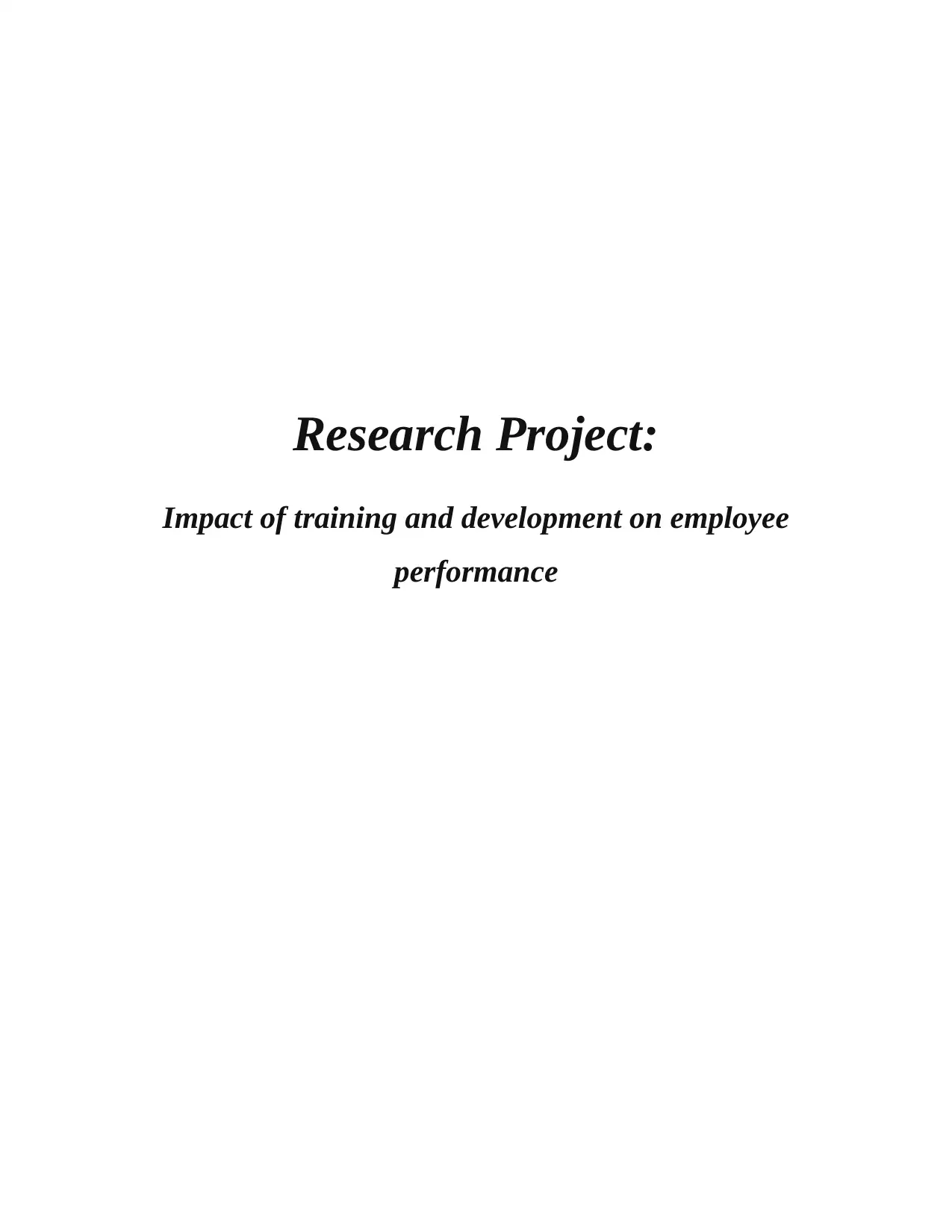
Research Project:
Impact of training and development on employee
performance
Impact of training and development on employee
performance
Paraphrase This Document
Need a fresh take? Get an instant paraphrase of this document with our AI Paraphraser
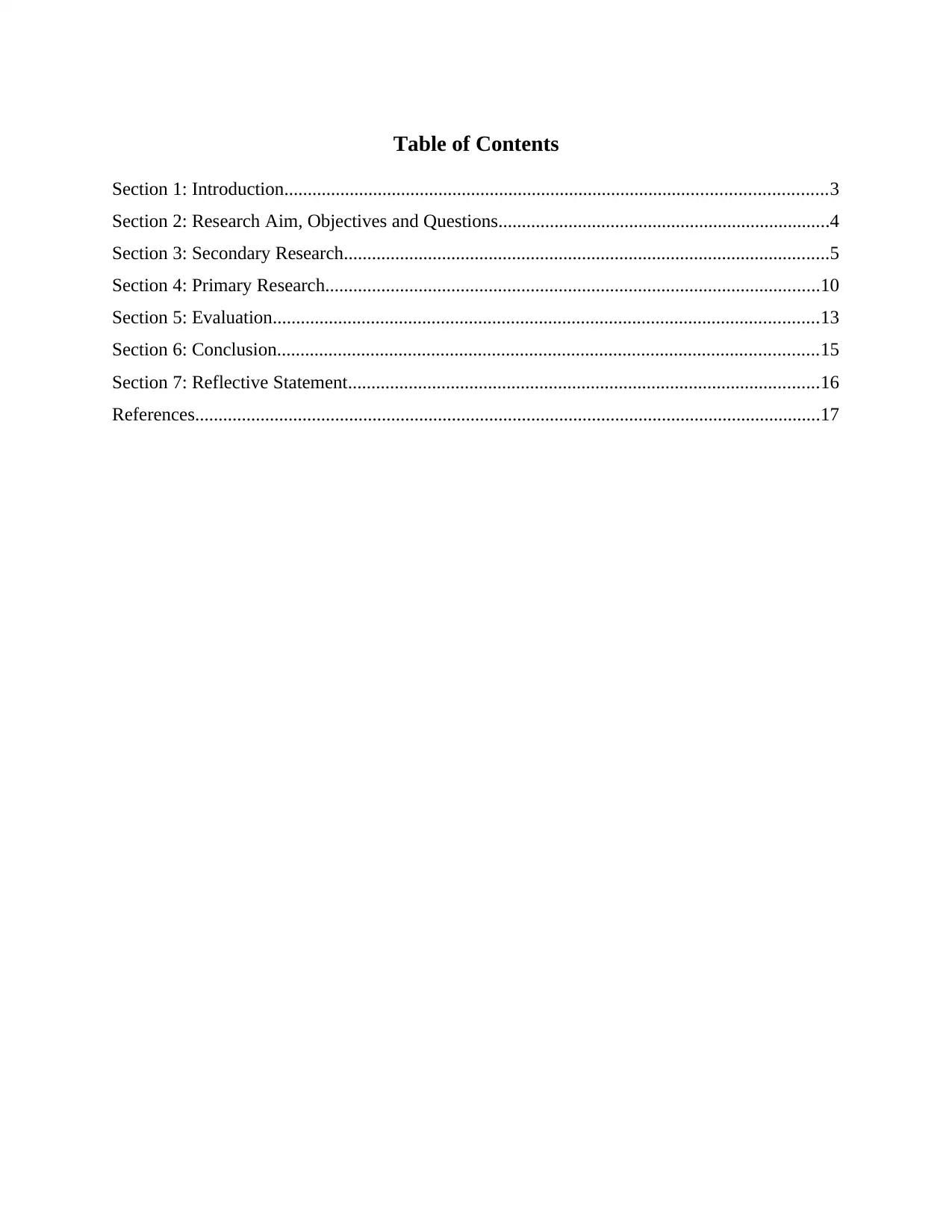
Table of Contents
Section 1: Introduction....................................................................................................................3
Section 2: Research Aim, Objectives and Questions.......................................................................4
Section 3: Secondary Research........................................................................................................5
Section 4: Primary Research..........................................................................................................10
Section 5: Evaluation.....................................................................................................................13
Section 6: Conclusion....................................................................................................................15
Section 7: Reflective Statement.....................................................................................................16
References......................................................................................................................................17
Section 1: Introduction....................................................................................................................3
Section 2: Research Aim, Objectives and Questions.......................................................................4
Section 3: Secondary Research........................................................................................................5
Section 4: Primary Research..........................................................................................................10
Section 5: Evaluation.....................................................................................................................13
Section 6: Conclusion....................................................................................................................15
Section 7: Reflective Statement.....................................................................................................16
References......................................................................................................................................17
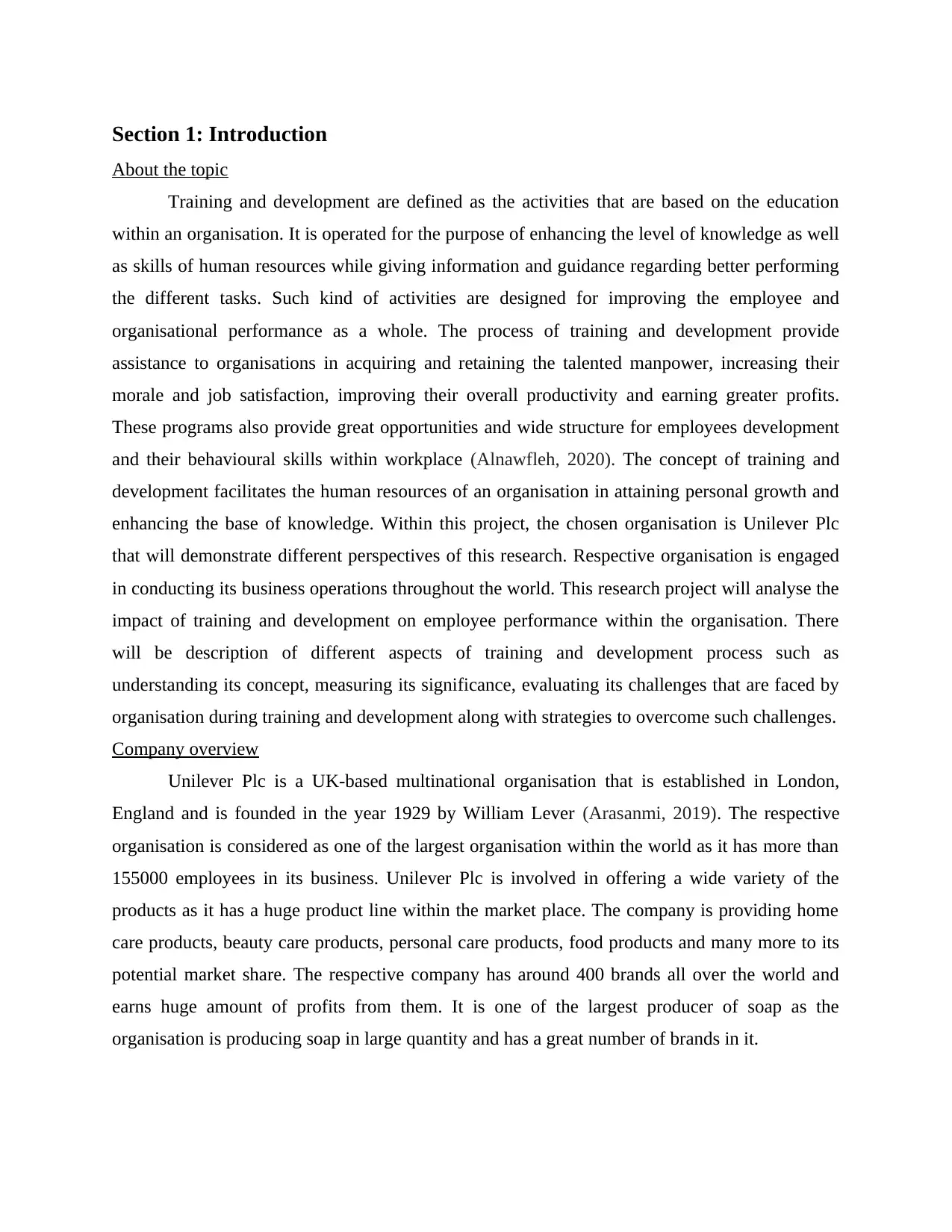
Section 1: Introduction
About the topic
Training and development are defined as the activities that are based on the education
within an organisation. It is operated for the purpose of enhancing the level of knowledge as well
as skills of human resources while giving information and guidance regarding better performing
the different tasks. Such kind of activities are designed for improving the employee and
organisational performance as a whole. The process of training and development provide
assistance to organisations in acquiring and retaining the talented manpower, increasing their
morale and job satisfaction, improving their overall productivity and earning greater profits.
These programs also provide great opportunities and wide structure for employees development
and their behavioural skills within workplace (Alnawfleh, 2020). The concept of training and
development facilitates the human resources of an organisation in attaining personal growth and
enhancing the base of knowledge. Within this project, the chosen organisation is Unilever Plc
that will demonstrate different perspectives of this research. Respective organisation is engaged
in conducting its business operations throughout the world. This research project will analyse the
impact of training and development on employee performance within the organisation. There
will be description of different aspects of training and development process such as
understanding its concept, measuring its significance, evaluating its challenges that are faced by
organisation during training and development along with strategies to overcome such challenges.
Company overview
Unilever Plc is a UK-based multinational organisation that is established in London,
England and is founded in the year 1929 by William Lever (Arasanmi, 2019). The respective
organisation is considered as one of the largest organisation within the world as it has more than
155000 employees in its business. Unilever Plc is involved in offering a wide variety of the
products as it has a huge product line within the market place. The company is providing home
care products, beauty care products, personal care products, food products and many more to its
potential market share. The respective company has around 400 brands all over the world and
earns huge amount of profits from them. It is one of the largest producer of soap as the
organisation is producing soap in large quantity and has a great number of brands in it.
About the topic
Training and development are defined as the activities that are based on the education
within an organisation. It is operated for the purpose of enhancing the level of knowledge as well
as skills of human resources while giving information and guidance regarding better performing
the different tasks. Such kind of activities are designed for improving the employee and
organisational performance as a whole. The process of training and development provide
assistance to organisations in acquiring and retaining the talented manpower, increasing their
morale and job satisfaction, improving their overall productivity and earning greater profits.
These programs also provide great opportunities and wide structure for employees development
and their behavioural skills within workplace (Alnawfleh, 2020). The concept of training and
development facilitates the human resources of an organisation in attaining personal growth and
enhancing the base of knowledge. Within this project, the chosen organisation is Unilever Plc
that will demonstrate different perspectives of this research. Respective organisation is engaged
in conducting its business operations throughout the world. This research project will analyse the
impact of training and development on employee performance within the organisation. There
will be description of different aspects of training and development process such as
understanding its concept, measuring its significance, evaluating its challenges that are faced by
organisation during training and development along with strategies to overcome such challenges.
Company overview
Unilever Plc is a UK-based multinational organisation that is established in London,
England and is founded in the year 1929 by William Lever (Arasanmi, 2019). The respective
organisation is considered as one of the largest organisation within the world as it has more than
155000 employees in its business. Unilever Plc is involved in offering a wide variety of the
products as it has a huge product line within the market place. The company is providing home
care products, beauty care products, personal care products, food products and many more to its
potential market share. The respective company has around 400 brands all over the world and
earns huge amount of profits from them. It is one of the largest producer of soap as the
organisation is producing soap in large quantity and has a great number of brands in it.
⊘ This is a preview!⊘
Do you want full access?
Subscribe today to unlock all pages.

Trusted by 1+ million students worldwide
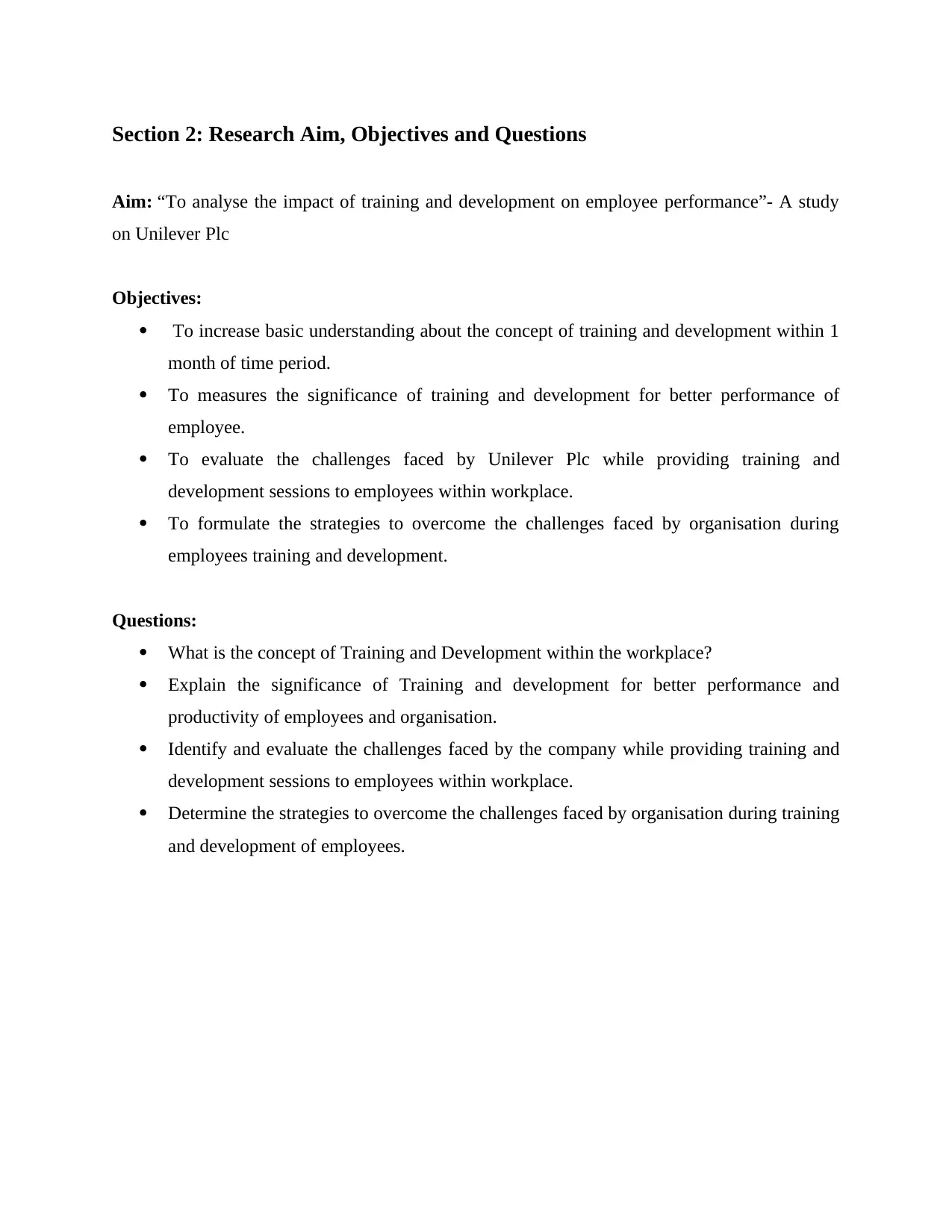
Section 2: Research Aim, Objectives and Questions
Aim: “To analyse the impact of training and development on employee performance”- A study
on Unilever Plc
Objectives:
To increase basic understanding about the concept of training and development within 1
month of time period.
To measures the significance of training and development for better performance of
employee.
To evaluate the challenges faced by Unilever Plc while providing training and
development sessions to employees within workplace.
To formulate the strategies to overcome the challenges faced by organisation during
employees training and development.
Questions:
What is the concept of Training and Development within the workplace?
Explain the significance of Training and development for better performance and
productivity of employees and organisation.
Identify and evaluate the challenges faced by the company while providing training and
development sessions to employees within workplace.
Determine the strategies to overcome the challenges faced by organisation during training
and development of employees.
Aim: “To analyse the impact of training and development on employee performance”- A study
on Unilever Plc
Objectives:
To increase basic understanding about the concept of training and development within 1
month of time period.
To measures the significance of training and development for better performance of
employee.
To evaluate the challenges faced by Unilever Plc while providing training and
development sessions to employees within workplace.
To formulate the strategies to overcome the challenges faced by organisation during
employees training and development.
Questions:
What is the concept of Training and Development within the workplace?
Explain the significance of Training and development for better performance and
productivity of employees and organisation.
Identify and evaluate the challenges faced by the company while providing training and
development sessions to employees within workplace.
Determine the strategies to overcome the challenges faced by organisation during training
and development of employees.
Paraphrase This Document
Need a fresh take? Get an instant paraphrase of this document with our AI Paraphraser
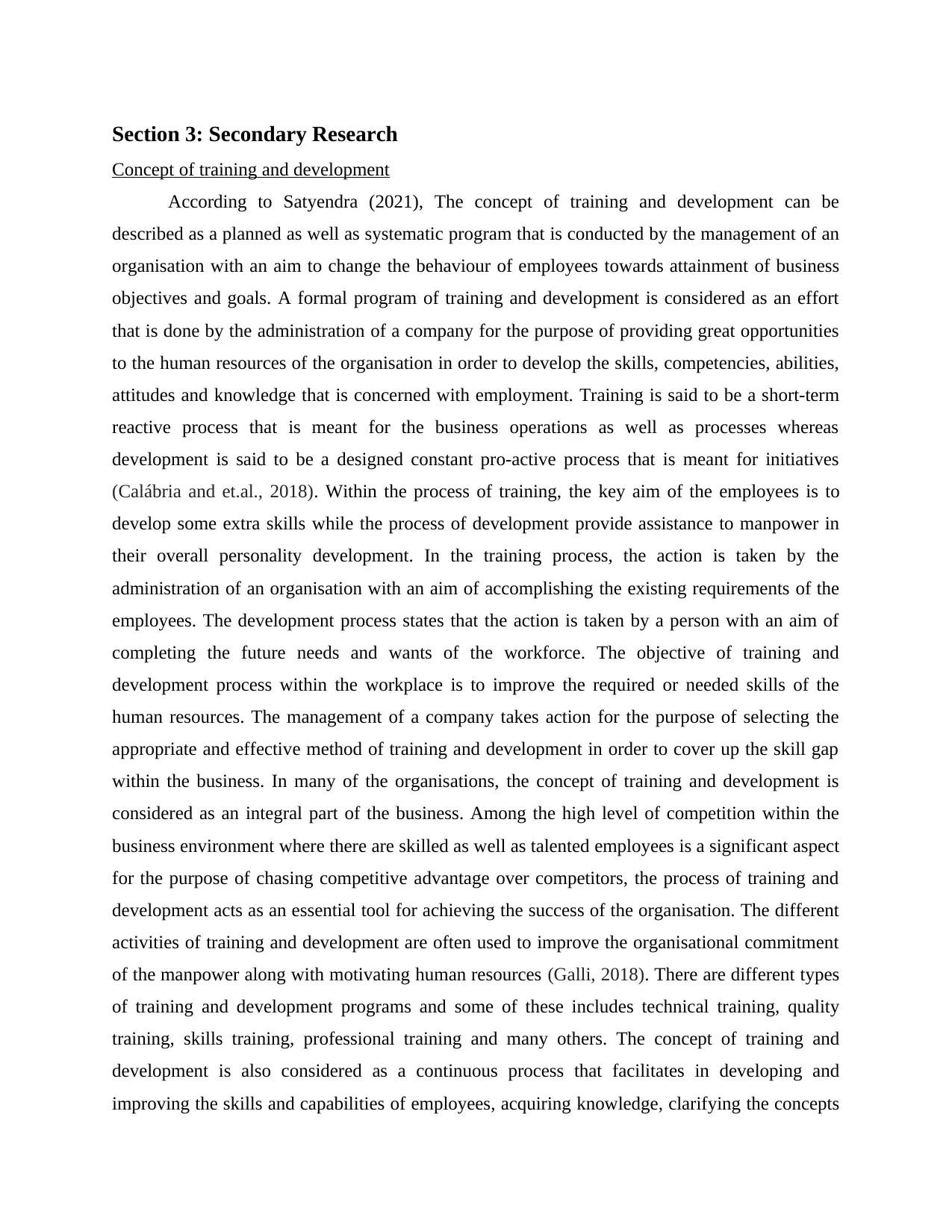
Section 3: Secondary Research
Concept of training and development
According to Satyendra (2021), The concept of training and development can be
described as a planned as well as systematic program that is conducted by the management of an
organisation with an aim to change the behaviour of employees towards attainment of business
objectives and goals. A formal program of training and development is considered as an effort
that is done by the administration of a company for the purpose of providing great opportunities
to the human resources of the organisation in order to develop the skills, competencies, abilities,
attitudes and knowledge that is concerned with employment. Training is said to be a short-term
reactive process that is meant for the business operations as well as processes whereas
development is said to be a designed constant pro-active process that is meant for initiatives
(Calábria and et.al., 2018). Within the process of training, the key aim of the employees is to
develop some extra skills while the process of development provide assistance to manpower in
their overall personality development. In the training process, the action is taken by the
administration of an organisation with an aim of accomplishing the existing requirements of the
employees. The development process states that the action is taken by a person with an aim of
completing the future needs and wants of the workforce. The objective of training and
development process within the workplace is to improve the required or needed skills of the
human resources. The management of a company takes action for the purpose of selecting the
appropriate and effective method of training and development in order to cover up the skill gap
within the business. In many of the organisations, the concept of training and development is
considered as an integral part of the business. Among the high level of competition within the
business environment where there are skilled as well as talented employees is a significant aspect
for the purpose of chasing competitive advantage over competitors, the process of training and
development acts as an essential tool for achieving the success of the organisation. The different
activities of training and development are often used to improve the organisational commitment
of the manpower along with motivating human resources (Galli, 2018). There are different types
of training and development programs and some of these includes technical training, quality
training, skills training, professional training and many others. The concept of training and
development is also considered as a continuous process that facilitates in developing and
improving the skills and capabilities of employees, acquiring knowledge, clarifying the concepts
Concept of training and development
According to Satyendra (2021), The concept of training and development can be
described as a planned as well as systematic program that is conducted by the management of an
organisation with an aim to change the behaviour of employees towards attainment of business
objectives and goals. A formal program of training and development is considered as an effort
that is done by the administration of a company for the purpose of providing great opportunities
to the human resources of the organisation in order to develop the skills, competencies, abilities,
attitudes and knowledge that is concerned with employment. Training is said to be a short-term
reactive process that is meant for the business operations as well as processes whereas
development is said to be a designed constant pro-active process that is meant for initiatives
(Calábria and et.al., 2018). Within the process of training, the key aim of the employees is to
develop some extra skills while the process of development provide assistance to manpower in
their overall personality development. In the training process, the action is taken by the
administration of an organisation with an aim of accomplishing the existing requirements of the
employees. The development process states that the action is taken by a person with an aim of
completing the future needs and wants of the workforce. The objective of training and
development process within the workplace is to improve the required or needed skills of the
human resources. The management of a company takes action for the purpose of selecting the
appropriate and effective method of training and development in order to cover up the skill gap
within the business. In many of the organisations, the concept of training and development is
considered as an integral part of the business. Among the high level of competition within the
business environment where there are skilled as well as talented employees is a significant aspect
for the purpose of chasing competitive advantage over competitors, the process of training and
development acts as an essential tool for achieving the success of the organisation. The different
activities of training and development are often used to improve the organisational commitment
of the manpower along with motivating human resources (Galli, 2018). There are different types
of training and development programs and some of these includes technical training, quality
training, skills training, professional training and many others. The concept of training and
development is also considered as a continuous process that facilitates in developing and
improving the skills and capabilities of employees, acquiring knowledge, clarifying the concepts
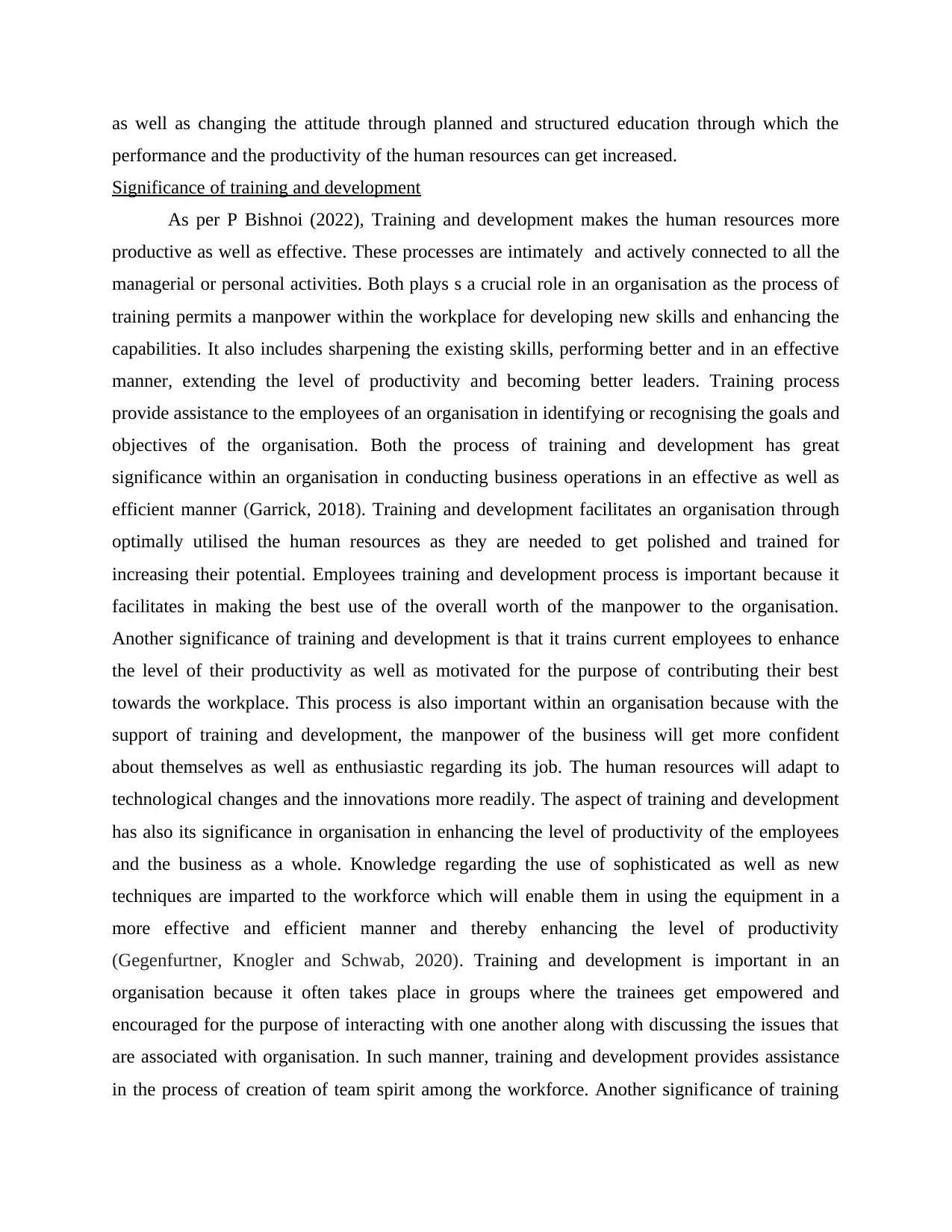
as well as changing the attitude through planned and structured education through which the
performance and the productivity of the human resources can get increased.
Significance of training and development
As per P Bishnoi (2022), Training and development makes the human resources more
productive as well as effective. These processes are intimately and actively connected to all the
managerial or personal activities. Both plays s a crucial role in an organisation as the process of
training permits a manpower within the workplace for developing new skills and enhancing the
capabilities. It also includes sharpening the existing skills, performing better and in an effective
manner, extending the level of productivity and becoming better leaders. Training process
provide assistance to the employees of an organisation in identifying or recognising the goals and
objectives of the organisation. Both the process of training and development has great
significance within an organisation in conducting business operations in an effective as well as
efficient manner (Garrick, 2018). Training and development facilitates an organisation through
optimally utilised the human resources as they are needed to get polished and trained for
increasing their potential. Employees training and development process is important because it
facilitates in making the best use of the overall worth of the manpower to the organisation.
Another significance of training and development is that it trains current employees to enhance
the level of their productivity as well as motivated for the purpose of contributing their best
towards the workplace. This process is also important within an organisation because with the
support of training and development, the manpower of the business will get more confident
about themselves as well as enthusiastic regarding its job. The human resources will adapt to
technological changes and the innovations more readily. The aspect of training and development
has also its significance in organisation in enhancing the level of productivity of the employees
and the business as a whole. Knowledge regarding the use of sophisticated as well as new
techniques are imparted to the workforce which will enable them in using the equipment in a
more effective and efficient manner and thereby enhancing the level of productivity
(Gegenfurtner, Knogler and Schwab, 2020). Training and development is important in an
organisation because it often takes place in groups where the trainees get empowered and
encouraged for the purpose of interacting with one another along with discussing the issues that
are associated with organisation. In such manner, training and development provides assistance
in the process of creation of team spirit among the workforce. Another significance of training
performance and the productivity of the human resources can get increased.
Significance of training and development
As per P Bishnoi (2022), Training and development makes the human resources more
productive as well as effective. These processes are intimately and actively connected to all the
managerial or personal activities. Both plays s a crucial role in an organisation as the process of
training permits a manpower within the workplace for developing new skills and enhancing the
capabilities. It also includes sharpening the existing skills, performing better and in an effective
manner, extending the level of productivity and becoming better leaders. Training process
provide assistance to the employees of an organisation in identifying or recognising the goals and
objectives of the organisation. Both the process of training and development has great
significance within an organisation in conducting business operations in an effective as well as
efficient manner (Garrick, 2018). Training and development facilitates an organisation through
optimally utilised the human resources as they are needed to get polished and trained for
increasing their potential. Employees training and development process is important because it
facilitates in making the best use of the overall worth of the manpower to the organisation.
Another significance of training and development is that it trains current employees to enhance
the level of their productivity as well as motivated for the purpose of contributing their best
towards the workplace. This process is also important within an organisation because with the
support of training and development, the manpower of the business will get more confident
about themselves as well as enthusiastic regarding its job. The human resources will adapt to
technological changes and the innovations more readily. The aspect of training and development
has also its significance in organisation in enhancing the level of productivity of the employees
and the business as a whole. Knowledge regarding the use of sophisticated as well as new
techniques are imparted to the workforce which will enable them in using the equipment in a
more effective and efficient manner and thereby enhancing the level of productivity
(Gegenfurtner, Knogler and Schwab, 2020). Training and development is important in an
organisation because it often takes place in groups where the trainees get empowered and
encouraged for the purpose of interacting with one another along with discussing the issues that
are associated with organisation. In such manner, training and development provides assistance
in the process of creation of team spirit among the workforce. Another significance of training
⊘ This is a preview!⊘
Do you want full access?
Subscribe today to unlock all pages.

Trusted by 1+ million students worldwide
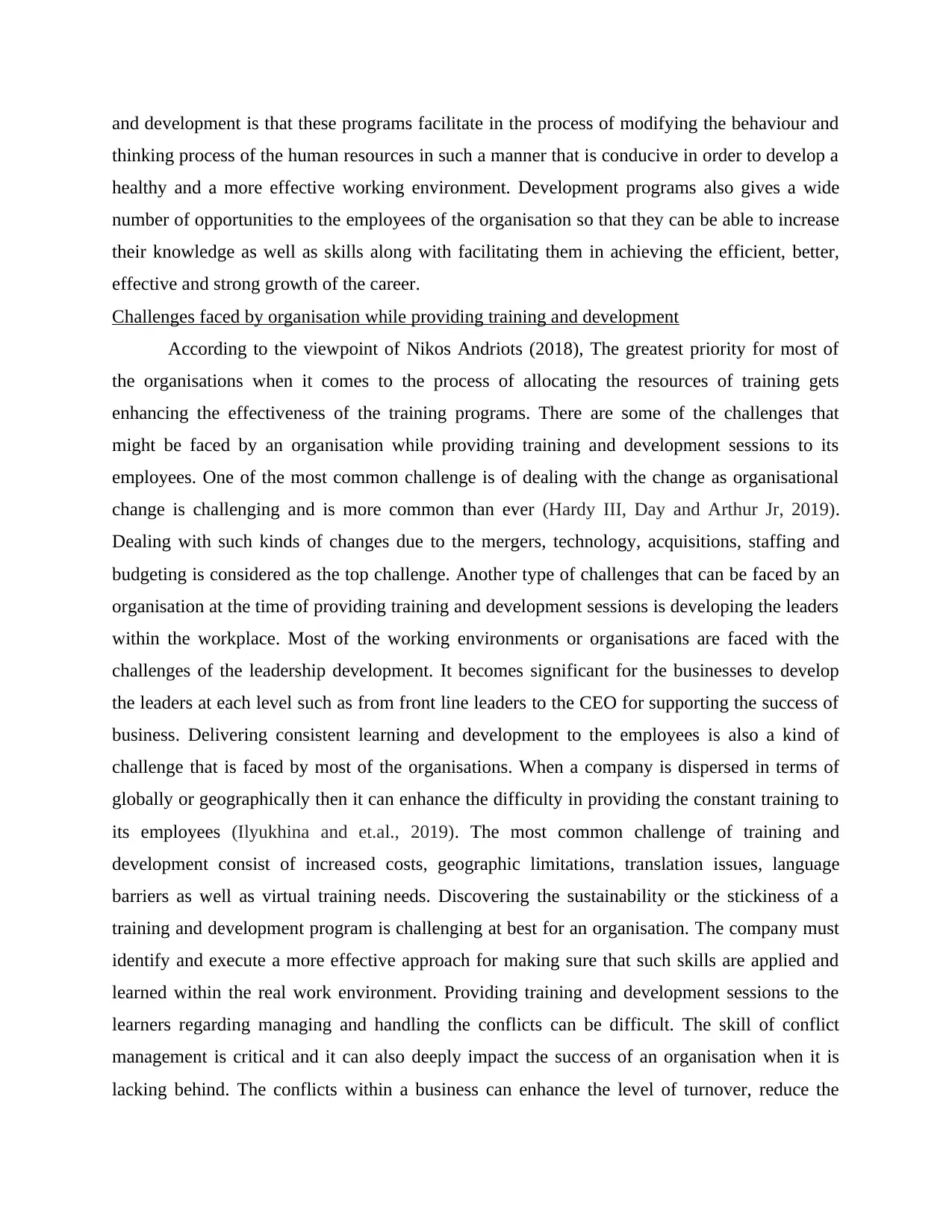
and development is that these programs facilitate in the process of modifying the behaviour and
thinking process of the human resources in such a manner that is conducive in order to develop a
healthy and a more effective working environment. Development programs also gives a wide
number of opportunities to the employees of the organisation so that they can be able to increase
their knowledge as well as skills along with facilitating them in achieving the efficient, better,
effective and strong growth of the career.
Challenges faced by organisation while providing training and development
According to the viewpoint of Nikos Andriots (2018), The greatest priority for most of
the organisations when it comes to the process of allocating the resources of training gets
enhancing the effectiveness of the training programs. There are some of the challenges that
might be faced by an organisation while providing training and development sessions to its
employees. One of the most common challenge is of dealing with the change as organisational
change is challenging and is more common than ever (Hardy III, Day and Arthur Jr, 2019).
Dealing with such kinds of changes due to the mergers, technology, acquisitions, staffing and
budgeting is considered as the top challenge. Another type of challenges that can be faced by an
organisation at the time of providing training and development sessions is developing the leaders
within the workplace. Most of the working environments or organisations are faced with the
challenges of the leadership development. It becomes significant for the businesses to develop
the leaders at each level such as from front line leaders to the CEO for supporting the success of
business. Delivering consistent learning and development to the employees is also a kind of
challenge that is faced by most of the organisations. When a company is dispersed in terms of
globally or geographically then it can enhance the difficulty in providing the constant training to
its employees (Ilyukhina and et.al., 2019). The most common challenge of training and
development consist of increased costs, geographic limitations, translation issues, language
barriers as well as virtual training needs. Discovering the sustainability or the stickiness of a
training and development program is challenging at best for an organisation. The company must
identify and execute a more effective approach for making sure that such skills are applied and
learned within the real work environment. Providing training and development sessions to the
learners regarding managing and handling the conflicts can be difficult. The skill of conflict
management is critical and it can also deeply impact the success of an organisation when it is
lacking behind. The conflicts within a business can enhance the level of turnover, reduce the
thinking process of the human resources in such a manner that is conducive in order to develop a
healthy and a more effective working environment. Development programs also gives a wide
number of opportunities to the employees of the organisation so that they can be able to increase
their knowledge as well as skills along with facilitating them in achieving the efficient, better,
effective and strong growth of the career.
Challenges faced by organisation while providing training and development
According to the viewpoint of Nikos Andriots (2018), The greatest priority for most of
the organisations when it comes to the process of allocating the resources of training gets
enhancing the effectiveness of the training programs. There are some of the challenges that
might be faced by an organisation while providing training and development sessions to its
employees. One of the most common challenge is of dealing with the change as organisational
change is challenging and is more common than ever (Hardy III, Day and Arthur Jr, 2019).
Dealing with such kinds of changes due to the mergers, technology, acquisitions, staffing and
budgeting is considered as the top challenge. Another type of challenges that can be faced by an
organisation at the time of providing training and development sessions is developing the leaders
within the workplace. Most of the working environments or organisations are faced with the
challenges of the leadership development. It becomes significant for the businesses to develop
the leaders at each level such as from front line leaders to the CEO for supporting the success of
business. Delivering consistent learning and development to the employees is also a kind of
challenge that is faced by most of the organisations. When a company is dispersed in terms of
globally or geographically then it can enhance the difficulty in providing the constant training to
its employees (Ilyukhina and et.al., 2019). The most common challenge of training and
development consist of increased costs, geographic limitations, translation issues, language
barriers as well as virtual training needs. Discovering the sustainability or the stickiness of a
training and development program is challenging at best for an organisation. The company must
identify and execute a more effective approach for making sure that such skills are applied and
learned within the real work environment. Providing training and development sessions to the
learners regarding managing and handling the conflicts can be difficult. The skill of conflict
management is critical and it can also deeply impact the success of an organisation when it is
lacking behind. The conflicts within a business can enhance the level of turnover, reduce the
Paraphrase This Document
Need a fresh take? Get an instant paraphrase of this document with our AI Paraphraser
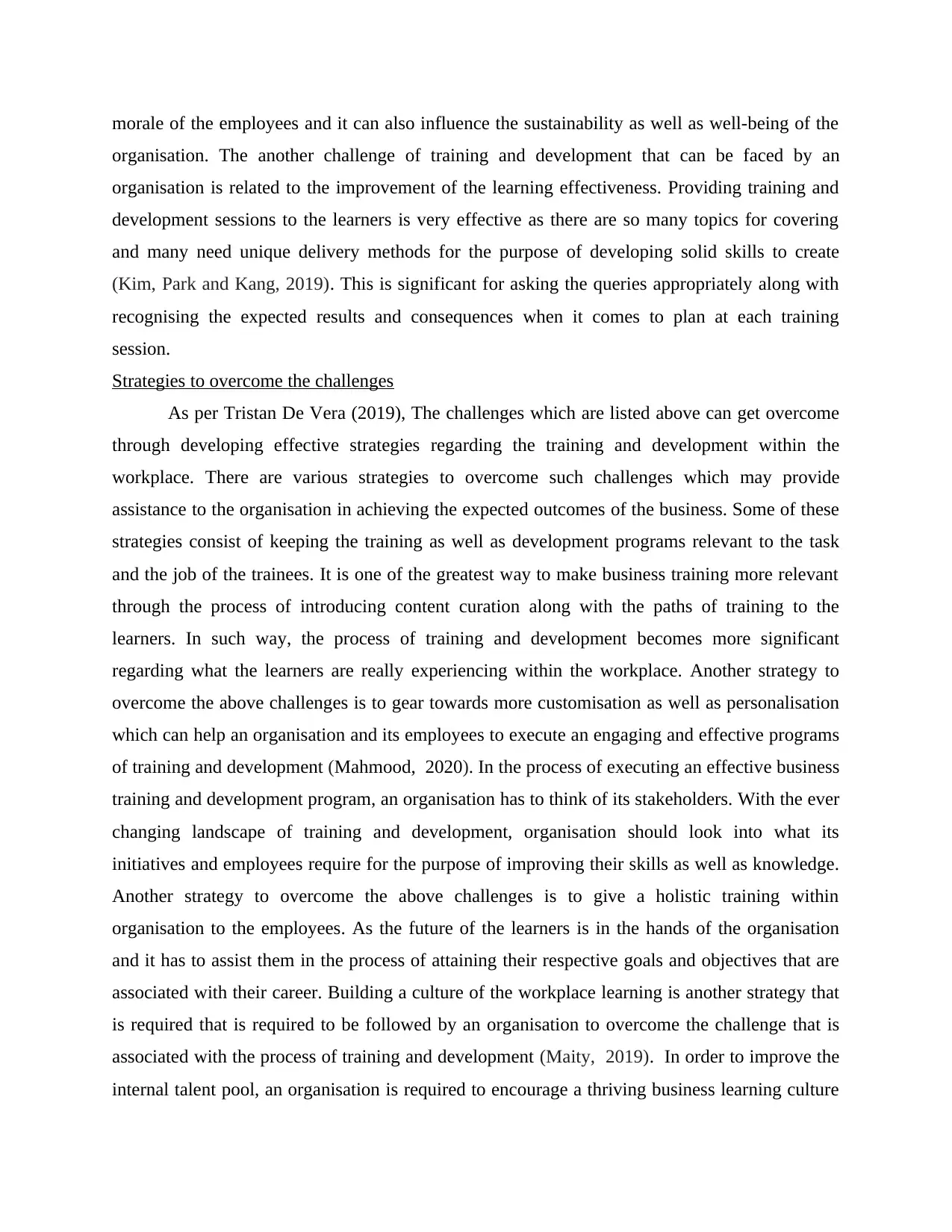
morale of the employees and it can also influence the sustainability as well as well-being of the
organisation. The another challenge of training and development that can be faced by an
organisation is related to the improvement of the learning effectiveness. Providing training and
development sessions to the learners is very effective as there are so many topics for covering
and many need unique delivery methods for the purpose of developing solid skills to create
(Kim, Park and Kang, 2019). This is significant for asking the queries appropriately along with
recognising the expected results and consequences when it comes to plan at each training
session.
Strategies to overcome the challenges
As per Tristan De Vera (2019), The challenges which are listed above can get overcome
through developing effective strategies regarding the training and development within the
workplace. There are various strategies to overcome such challenges which may provide
assistance to the organisation in achieving the expected outcomes of the business. Some of these
strategies consist of keeping the training as well as development programs relevant to the task
and the job of the trainees. It is one of the greatest way to make business training more relevant
through the process of introducing content curation along with the paths of training to the
learners. In such way, the process of training and development becomes more significant
regarding what the learners are really experiencing within the workplace. Another strategy to
overcome the above challenges is to gear towards more customisation as well as personalisation
which can help an organisation and its employees to execute an engaging and effective programs
of training and development (Mahmood, 2020). In the process of executing an effective business
training and development program, an organisation has to think of its stakeholders. With the ever
changing landscape of training and development, organisation should look into what its
initiatives and employees require for the purpose of improving their skills as well as knowledge.
Another strategy to overcome the above challenges is to give a holistic training within
organisation to the employees. As the future of the learners is in the hands of the organisation
and it has to assist them in the process of attaining their respective goals and objectives that are
associated with their career. Building a culture of the workplace learning is another strategy that
is required that is required to be followed by an organisation to overcome the challenge that is
associated with the process of training and development (Maity, 2019). In order to improve the
internal talent pool, an organisation is required to encourage a thriving business learning culture
organisation. The another challenge of training and development that can be faced by an
organisation is related to the improvement of the learning effectiveness. Providing training and
development sessions to the learners is very effective as there are so many topics for covering
and many need unique delivery methods for the purpose of developing solid skills to create
(Kim, Park and Kang, 2019). This is significant for asking the queries appropriately along with
recognising the expected results and consequences when it comes to plan at each training
session.
Strategies to overcome the challenges
As per Tristan De Vera (2019), The challenges which are listed above can get overcome
through developing effective strategies regarding the training and development within the
workplace. There are various strategies to overcome such challenges which may provide
assistance to the organisation in achieving the expected outcomes of the business. Some of these
strategies consist of keeping the training as well as development programs relevant to the task
and the job of the trainees. It is one of the greatest way to make business training more relevant
through the process of introducing content curation along with the paths of training to the
learners. In such way, the process of training and development becomes more significant
regarding what the learners are really experiencing within the workplace. Another strategy to
overcome the above challenges is to gear towards more customisation as well as personalisation
which can help an organisation and its employees to execute an engaging and effective programs
of training and development (Mahmood, 2020). In the process of executing an effective business
training and development program, an organisation has to think of its stakeholders. With the ever
changing landscape of training and development, organisation should look into what its
initiatives and employees require for the purpose of improving their skills as well as knowledge.
Another strategy to overcome the above challenges is to give a holistic training within
organisation to the employees. As the future of the learners is in the hands of the organisation
and it has to assist them in the process of attaining their respective goals and objectives that are
associated with their career. Building a culture of the workplace learning is another strategy that
is required that is required to be followed by an organisation to overcome the challenge that is
associated with the process of training and development (Maity, 2019). In order to improve the
internal talent pool, an organisation is required to encourage a thriving business learning culture

and it should also try to ask the learners regarding their expectations and requirements to learn to
improve their working performance.
improve their working performance.
⊘ This is a preview!⊘
Do you want full access?
Subscribe today to unlock all pages.

Trusted by 1+ million students worldwide
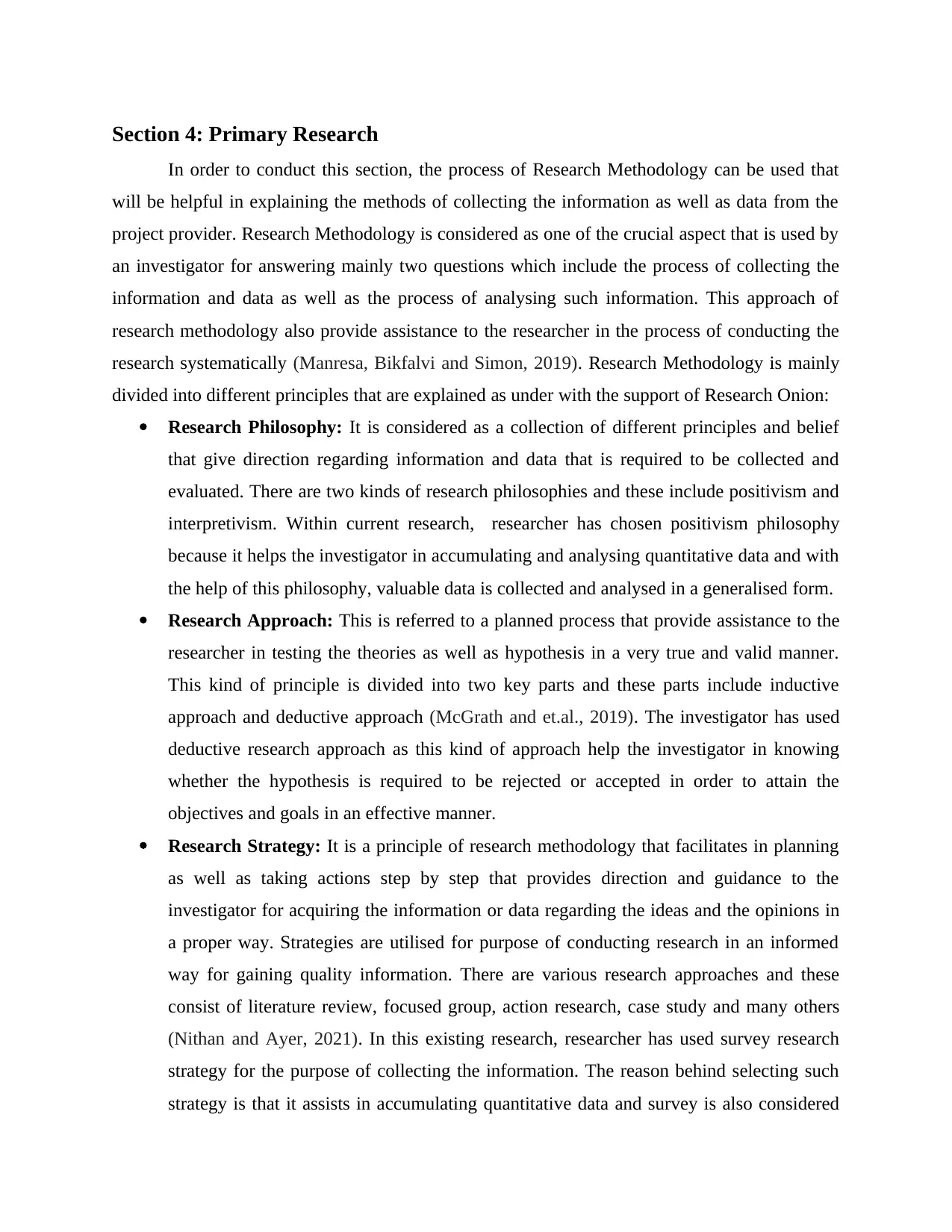
Section 4: Primary Research
In order to conduct this section, the process of Research Methodology can be used that
will be helpful in explaining the methods of collecting the information as well as data from the
project provider. Research Methodology is considered as one of the crucial aspect that is used by
an investigator for answering mainly two questions which include the process of collecting the
information and data as well as the process of analysing such information. This approach of
research methodology also provide assistance to the researcher in the process of conducting the
research systematically (Manresa, Bikfalvi and Simon, 2019). Research Methodology is mainly
divided into different principles that are explained as under with the support of Research Onion:
Research Philosophy: It is considered as a collection of different principles and belief
that give direction regarding information and data that is required to be collected and
evaluated. There are two kinds of research philosophies and these include positivism and
interpretivism. Within current research, researcher has chosen positivism philosophy
because it helps the investigator in accumulating and analysing quantitative data and with
the help of this philosophy, valuable data is collected and analysed in a generalised form.
Research Approach: This is referred to a planned process that provide assistance to the
researcher in testing the theories as well as hypothesis in a very true and valid manner.
This kind of principle is divided into two key parts and these parts include inductive
approach and deductive approach (McGrath and et.al., 2019). The investigator has used
deductive research approach as this kind of approach help the investigator in knowing
whether the hypothesis is required to be rejected or accepted in order to attain the
objectives and goals in an effective manner.
Research Strategy: It is a principle of research methodology that facilitates in planning
as well as taking actions step by step that provides direction and guidance to the
investigator for acquiring the information or data regarding the ideas and the opinions in
a proper way. Strategies are utilised for purpose of conducting research in an informed
way for gaining quality information. There are various research approaches and these
consist of literature review, focused group, action research, case study and many others
(Nithan and Ayer, 2021). In this existing research, researcher has used survey research
strategy for the purpose of collecting the information. The reason behind selecting such
strategy is that it assists in accumulating quantitative data and survey is also considered
In order to conduct this section, the process of Research Methodology can be used that
will be helpful in explaining the methods of collecting the information as well as data from the
project provider. Research Methodology is considered as one of the crucial aspect that is used by
an investigator for answering mainly two questions which include the process of collecting the
information and data as well as the process of analysing such information. This approach of
research methodology also provide assistance to the researcher in the process of conducting the
research systematically (Manresa, Bikfalvi and Simon, 2019). Research Methodology is mainly
divided into different principles that are explained as under with the support of Research Onion:
Research Philosophy: It is considered as a collection of different principles and belief
that give direction regarding information and data that is required to be collected and
evaluated. There are two kinds of research philosophies and these include positivism and
interpretivism. Within current research, researcher has chosen positivism philosophy
because it helps the investigator in accumulating and analysing quantitative data and with
the help of this philosophy, valuable data is collected and analysed in a generalised form.
Research Approach: This is referred to a planned process that provide assistance to the
researcher in testing the theories as well as hypothesis in a very true and valid manner.
This kind of principle is divided into two key parts and these parts include inductive
approach and deductive approach (McGrath and et.al., 2019). The investigator has used
deductive research approach as this kind of approach help the investigator in knowing
whether the hypothesis is required to be rejected or accepted in order to attain the
objectives and goals in an effective manner.
Research Strategy: It is a principle of research methodology that facilitates in planning
as well as taking actions step by step that provides direction and guidance to the
investigator for acquiring the information or data regarding the ideas and the opinions in
a proper way. Strategies are utilised for purpose of conducting research in an informed
way for gaining quality information. There are various research approaches and these
consist of literature review, focused group, action research, case study and many others
(Nithan and Ayer, 2021). In this existing research, researcher has used survey research
strategy for the purpose of collecting the information. The reason behind selecting such
strategy is that it assists in accumulating quantitative data and survey is also considered
Paraphrase This Document
Need a fresh take? Get an instant paraphrase of this document with our AI Paraphraser
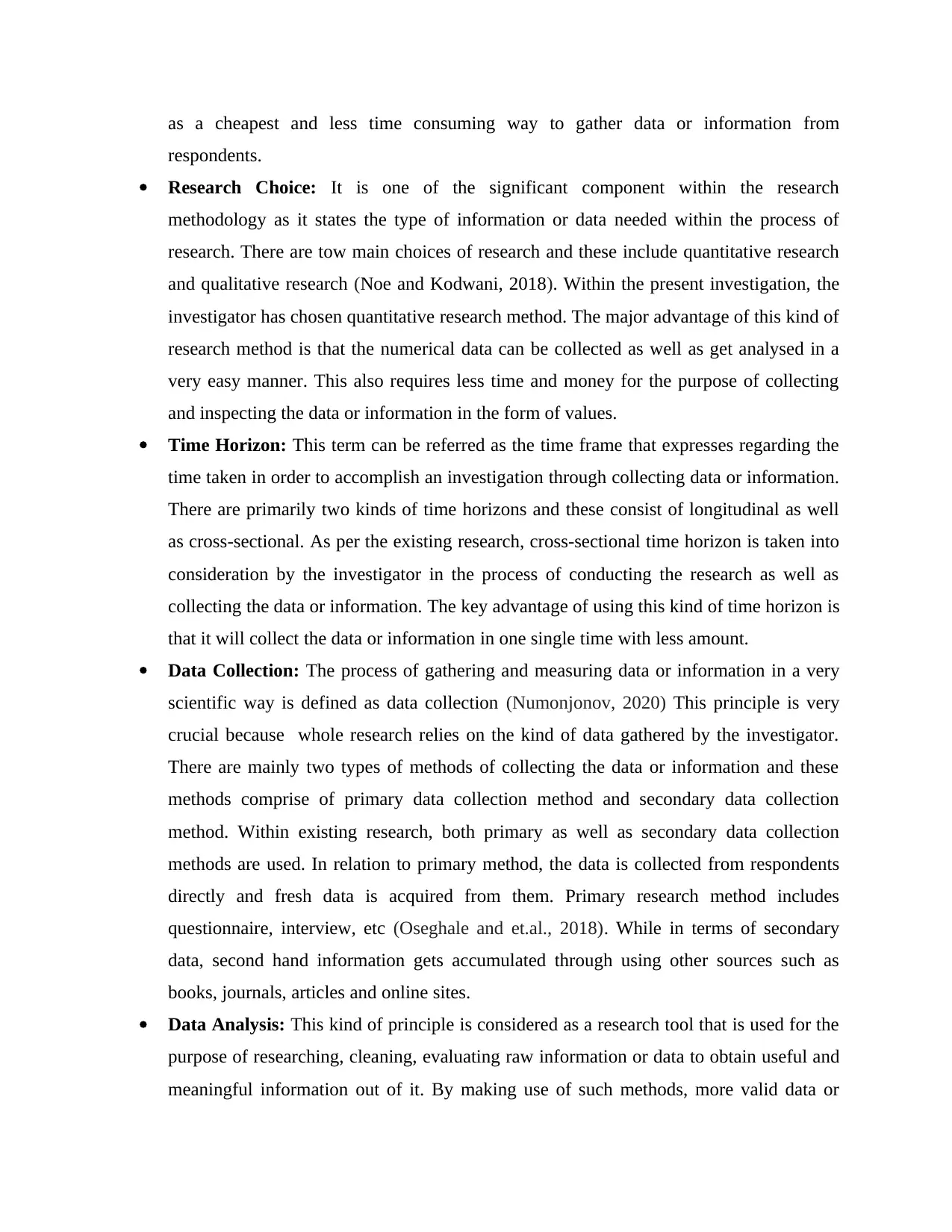
as a cheapest and less time consuming way to gather data or information from
respondents.
Research Choice: It is one of the significant component within the research
methodology as it states the type of information or data needed within the process of
research. There are tow main choices of research and these include quantitative research
and qualitative research (Noe and Kodwani, 2018). Within the present investigation, the
investigator has chosen quantitative research method. The major advantage of this kind of
research method is that the numerical data can be collected as well as get analysed in a
very easy manner. This also requires less time and money for the purpose of collecting
and inspecting the data or information in the form of values.
Time Horizon: This term can be referred as the time frame that expresses regarding the
time taken in order to accomplish an investigation through collecting data or information.
There are primarily two kinds of time horizons and these consist of longitudinal as well
as cross-sectional. As per the existing research, cross-sectional time horizon is taken into
consideration by the investigator in the process of conducting the research as well as
collecting the data or information. The key advantage of using this kind of time horizon is
that it will collect the data or information in one single time with less amount.
Data Collection: The process of gathering and measuring data or information in a very
scientific way is defined as data collection (Numonjonov, 2020) This principle is very
crucial because whole research relies on the kind of data gathered by the investigator.
There are mainly two types of methods of collecting the data or information and these
methods comprise of primary data collection method and secondary data collection
method. Within existing research, both primary as well as secondary data collection
methods are used. In relation to primary method, the data is collected from respondents
directly and fresh data is acquired from them. Primary research method includes
questionnaire, interview, etc (Oseghale and et.al., 2018). While in terms of secondary
data, second hand information gets accumulated through using other sources such as
books, journals, articles and online sites.
Data Analysis: This kind of principle is considered as a research tool that is used for the
purpose of researching, cleaning, evaluating raw information or data to obtain useful and
meaningful information out of it. By making use of such methods, more valid data or
respondents.
Research Choice: It is one of the significant component within the research
methodology as it states the type of information or data needed within the process of
research. There are tow main choices of research and these include quantitative research
and qualitative research (Noe and Kodwani, 2018). Within the present investigation, the
investigator has chosen quantitative research method. The major advantage of this kind of
research method is that the numerical data can be collected as well as get analysed in a
very easy manner. This also requires less time and money for the purpose of collecting
and inspecting the data or information in the form of values.
Time Horizon: This term can be referred as the time frame that expresses regarding the
time taken in order to accomplish an investigation through collecting data or information.
There are primarily two kinds of time horizons and these consist of longitudinal as well
as cross-sectional. As per the existing research, cross-sectional time horizon is taken into
consideration by the investigator in the process of conducting the research as well as
collecting the data or information. The key advantage of using this kind of time horizon is
that it will collect the data or information in one single time with less amount.
Data Collection: The process of gathering and measuring data or information in a very
scientific way is defined as data collection (Numonjonov, 2020) This principle is very
crucial because whole research relies on the kind of data gathered by the investigator.
There are mainly two types of methods of collecting the data or information and these
methods comprise of primary data collection method and secondary data collection
method. Within existing research, both primary as well as secondary data collection
methods are used. In relation to primary method, the data is collected from respondents
directly and fresh data is acquired from them. Primary research method includes
questionnaire, interview, etc (Oseghale and et.al., 2018). While in terms of secondary
data, second hand information gets accumulated through using other sources such as
books, journals, articles and online sites.
Data Analysis: This kind of principle is considered as a research tool that is used for the
purpose of researching, cleaning, evaluating raw information or data to obtain useful and
meaningful information out of it. By making use of such methods, more valid data or
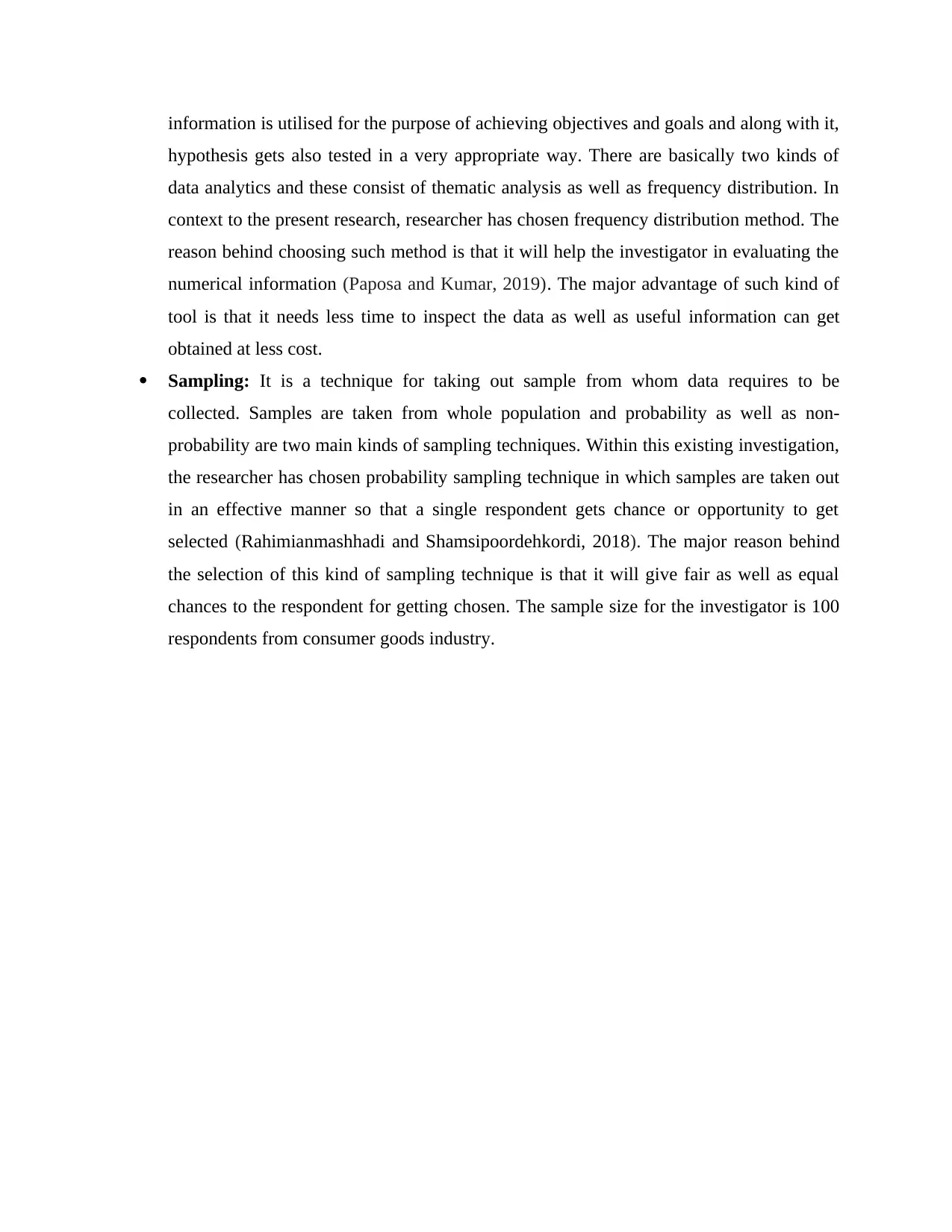
information is utilised for the purpose of achieving objectives and goals and along with it,
hypothesis gets also tested in a very appropriate way. There are basically two kinds of
data analytics and these consist of thematic analysis as well as frequency distribution. In
context to the present research, researcher has chosen frequency distribution method. The
reason behind choosing such method is that it will help the investigator in evaluating the
numerical information (Paposa and Kumar, 2019). The major advantage of such kind of
tool is that it needs less time to inspect the data as well as useful information can get
obtained at less cost.
Sampling: It is a technique for taking out sample from whom data requires to be
collected. Samples are taken from whole population and probability as well as non-
probability are two main kinds of sampling techniques. Within this existing investigation,
the researcher has chosen probability sampling technique in which samples are taken out
in an effective manner so that a single respondent gets chance or opportunity to get
selected (Rahimianmashhadi and Shamsipoordehkordi, 2018). The major reason behind
the selection of this kind of sampling technique is that it will give fair as well as equal
chances to the respondent for getting chosen. The sample size for the investigator is 100
respondents from consumer goods industry.
hypothesis gets also tested in a very appropriate way. There are basically two kinds of
data analytics and these consist of thematic analysis as well as frequency distribution. In
context to the present research, researcher has chosen frequency distribution method. The
reason behind choosing such method is that it will help the investigator in evaluating the
numerical information (Paposa and Kumar, 2019). The major advantage of such kind of
tool is that it needs less time to inspect the data as well as useful information can get
obtained at less cost.
Sampling: It is a technique for taking out sample from whom data requires to be
collected. Samples are taken from whole population and probability as well as non-
probability are two main kinds of sampling techniques. Within this existing investigation,
the researcher has chosen probability sampling technique in which samples are taken out
in an effective manner so that a single respondent gets chance or opportunity to get
selected (Rahimianmashhadi and Shamsipoordehkordi, 2018). The major reason behind
the selection of this kind of sampling technique is that it will give fair as well as equal
chances to the respondent for getting chosen. The sample size for the investigator is 100
respondents from consumer goods industry.
⊘ This is a preview!⊘
Do you want full access?
Subscribe today to unlock all pages.

Trusted by 1+ million students worldwide
1 out of 18
Related Documents
Your All-in-One AI-Powered Toolkit for Academic Success.
+13062052269
info@desklib.com
Available 24*7 on WhatsApp / Email
![[object Object]](/_next/static/media/star-bottom.7253800d.svg)
Unlock your academic potential
Copyright © 2020–2025 A2Z Services. All Rights Reserved. Developed and managed by ZUCOL.

